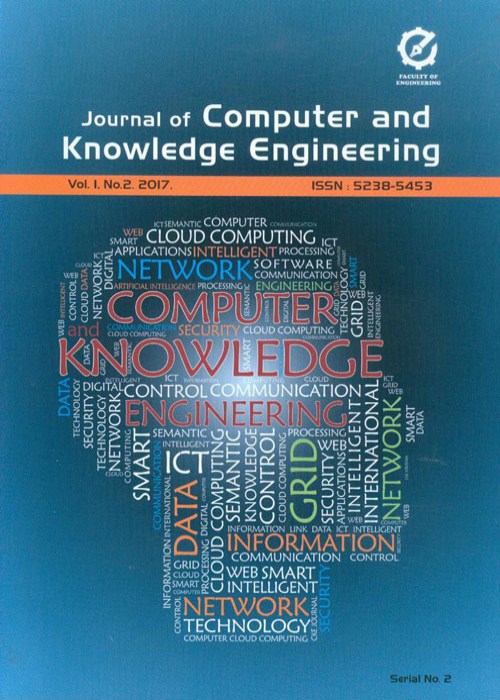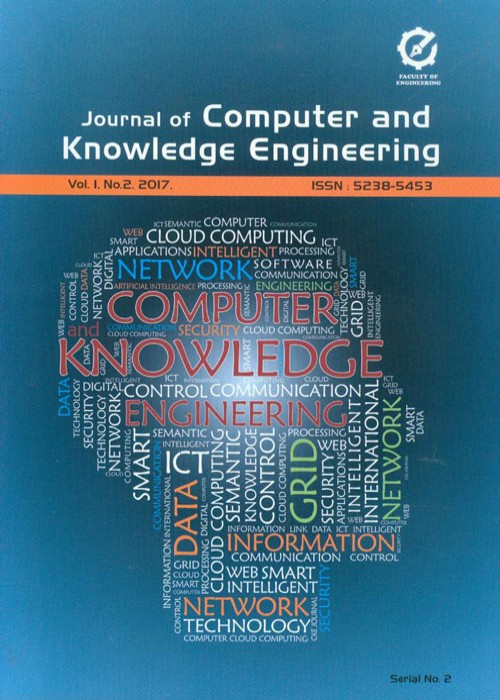فهرست مطالب

Journal of Computer and Knowledge Engineering
Volume:5 Issue: 1, Winter-Spring 2022
- تاریخ انتشار: 1401/10/14
- تعداد عناوین: 6
-
-
Pages 1-12In cloud computing, task scheduling is one of the most important issues that need to be considered for enhancing system performance and user satisfaction. Although there are many task scheduling strategies, available algorithms mainly focus on reducing the execution time while ignoring the profits of service providers. In order to improve provider profitability as well as meet the user requirements, tasks should be executed with minimal cost and without violating Quality of Service (QoS) restrictions. This study presents a Cost and Energy-aware Task Scheduling Algorithm (CETSA) intending to reduce makespan, energy consumption, and cost. The proposed algorithm considers the trade-off between cost, energy consumption, and makespan while considering the load on each virtual machine to prevent virtual machines from overloading. Experimental results with CloudSim show that the CETSA algorithm has better results in terms of energy consumption, waiting time, success rate, cost, improvement ratio, and degree of imbalance compared with MSDE, CPSO, CJS, and FUGE.Keywords: Cloud, Task scheduling, Cost, Energy Consumption, Makespan
-
Pages 13-20One of the most important problems in computational linguistics is the grammar and, consequently, syntactic structures and structural parsing. The structural parser tries to analyze the relationships between words and to extract the syntactic structure of the sentence. The dependency-based structural parser is proper for free-word-order and morphologically-rich languages such as Persian. The data-driven dependency parser performs the categorization process based on a wide range of features, which, in addition to the problems such as sparsity and curse of dimensionality, it requires the correct selection of the features and proper setting of the parameters. The aim of this study is to obtain high performance with minimal feature engineering for dependency parsing of Persian sentences. In order to achieve this goal, the required features of the Maximum Spanning Tree Parser (MSTParser) are extracted with a Bidirectional Long Short-Term Memory (Bi-LSTM) Network and the edges of the dependency graph is scored by that. Experiments are conducted on the Persian Dependency Treebank (PerDT) and the Uppsala Persian Dependency Treebank (UPDT). The obtained results indicate that the definition of new features improves the performance of the dependency parser for Persian. The achieved unlabeled attachment scores for PerDT and UPDT are 90.53% and 87.02%, respectively.Keywords: Dependency Parser, MSTParser, Phrase-structure Tree, deep Learning, Persian
-
Pages 21-37A complex system is a system that has many components that are interdependent and appear as a whole and exhibit organized behavior. Community structure detection is an optimization problem in complex networks that involves searching for communities belonging to a network that shares nodes of a similar community with standard features. In this paper, we use a multi-agent memetic algorithm to detect the structure of the community in complex networks by optimizing the amount of modularity and calling it MAMA-Net. In the multi-agent memetic algorithm, agents are placed in a network-like environment to detect the community. Local search is used to find solution space. Having a local search in the memetic algorithm allows each member of the population to increase its evaluation function based on the suitability of its neighbors and achieve the desired result in minimum time. We compare the performance of MAMA-Net in detecting community structure with some standard algorithms. Both real-world and synthetic benchmark networks are used to evaluate the performance of the proposed method. The results show that MAMA-Net could detect communities more accurately than other comparable algorithms.Keywords: Complex systems, Multi-agent systems, memetic algorithm, Community detection
-
Pages 37-46The problem of influence maximization is selecting the most influential individuals in a social network. With the popularity of social network sites and the development of viral marketing, the importance of the problem has increased. The influence maximization problem is NP-hard, and therefore, there will not exist any polynomial-time algorithm to solve the problem unless P = NP. Many heuristics are proposed for finding a nearly good solution in a shorter time. This study proposes two heuristic algorithms for finding good solutions. The heuristics are based on two ideas: 1) vertices of high degree have more influence in the network, and 2) nearby vertices influence on almost analogous sets of vertices. We evaluate our algorithms on several well-known data sets and show that our heuristics achieve better results (up to 15% in the influence spread) for this problem in a shorter time (up to 85% improvement in the running time).Keywords: Degree centrality, Heuristic algorithm, Independent cascade model, Influence maximization
-
Pages 47-58Neural Architecture Search (NAS), which automatically designs a neural architecture for a specific task, has attracted much attention in recent years. Properly defining the search space is a key step in the success of NAS approaches, which allows us to reduce the required time for evaluation. Thus, late strategies for searching a NAS space is to leverage supervised learning models for ranking the potential neural models, i.e., surrogate predictive models. The predictive model takes the specification of an architecture (or its feature representation) and predicts the probable efficiency of the model ahead of training. Therefore, proper representation of a candidate architecture is an important factor for a predictor NAS approach. While several works have been devoted to training a good surrogate model, there exits limited research focusing on learning a good representation for these neural models. To address this problem, we investigate how to learn a representation with both structural and non-structural features of a network. In particular, we propose a tree structured encoding which permits to fully represent both networks’ layers and their intra-connections. The encoding is easily extendable to larger or more complex structures. Extensive experiments on two NAS datasets, NasBench101 and NasBench201, demonstrate the effectiveness of the proposed method as compared with the state-of-the-art predictors.Keywords: Neural Architecture Search, Search Space Pruning, Network Architecture, Representation Learning
-
Pages 59-68Todays, although social networks are used for extensive information sharing, spreading rumors has also been accelerated and become a serious problem. Rumor control can be accomplished through either hard or soft control strategies. The former uses depriving actions like blocking rumor spreaders, while the latter tries to persuade people personally avoiding rumor propagation by increasing their knowledge and awareness. Although there are some proposals for rumor control in social networks, suitable frameworks for modeling and analysis of rumor control strategies and methods with proper consideration of the effective factors is still a need. This study introduces a rumor propagation model based on evolutionary game theory along with a number of soft and hard rumor control methods. Using the proposed model, we simulate and analyze rumor control methods considering different environmental, personal, and content-related factors that may influence people's decisions about rumors. The simulation is conducted on a Twitter graph according to various society conditions. One of the findings is that the soft rumor control strategy is generally more effective than the hard rumor control strategy. The proposed model itself and the conducted analysis can be adopted for developing and deploying effective rumor control mechanisms in social network systems.Keywords: Evolutionary Game Theory, Rumor spreading, Rumor control, Social network


